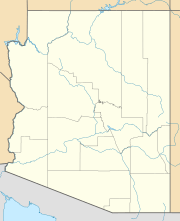House Mountain (Arizona) facts for kids
Quick facts for kids House Mountain |
|
|---|---|
| Highest point | |
| Elevation | 5,131 ft (1,564 m) NAVD 88 |
| Prominence | 927 ft (283 m) |
| Geography | |
| Location | Yavapai County, Arizona, U.S. |
| Topo map | USGS Sedona |
| Climbing | |
| Easiest route | Hike |
House Mountain is a cool shield volcano located in the southwestern U.S. state of Arizona. It sits between the beautiful Red Rock Country near Sedona and the Verde Valley. You can find it within the Coconino National Forest.
This mountain is called a "shield volcano" because it looks like a warrior's shield lying on the ground. This shape comes from the way its lava flowed out slowly and spread far and wide, making gentle slopes.
Contents
How House Mountain Formed
House Mountain erupted a very long time ago, about 13 to 15 million years ago. Back then, it was right on the edge of a big cliff called the Mogollon Rim.
When the volcano erupted, it poured out a type of dark, volcanic rock called basalt. This basalt lava covered and protected the older layers of rock underneath it.
Over millions of years, the Mogollon Rim has slowly moved back. It moves about one foot every 600 years! So, the edge of the rim you see today is several miles away from House Mountain's summit.
Seeing and Hiking House Mountain
You can easily spot House Mountain if you're driving on State Route 89A between Sedona and Cottonwood. It's a noticeable landmark in the landscape.
The Turkey Creek Trail
If you like hiking, the Turkey Creek Trail is a great way to explore House Mountain. This trail climbs for about 3 miles up to the northern edge of the volcano's caldera.
A caldera is like a giant bowl-shaped hollow. It forms when the ground collapses after a volcano erupts and empties its magma chamber.
From the northern rim, you can follow an old Jeep trail road. This road goes down into the "bowl" of the caldera and then up to the southern rim.
Reaching the Summit
After reaching the southern rim, it's a bit of a steep climb to the very top. This last part is "off-trail," meaning there isn't a marked path.
House Mountain got its name because its rocky top looks a bit like a house when you see it from the Verde Valley below.


